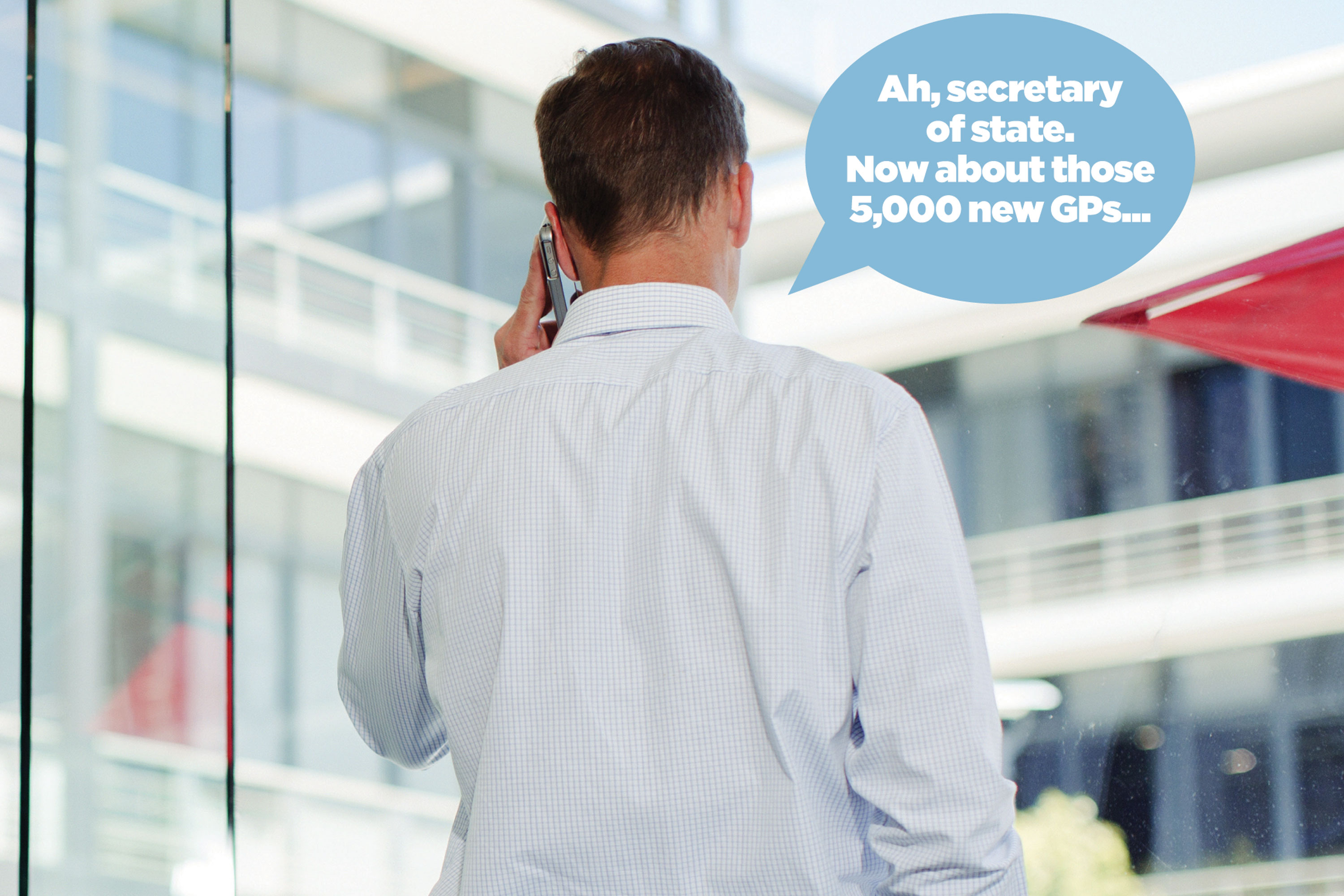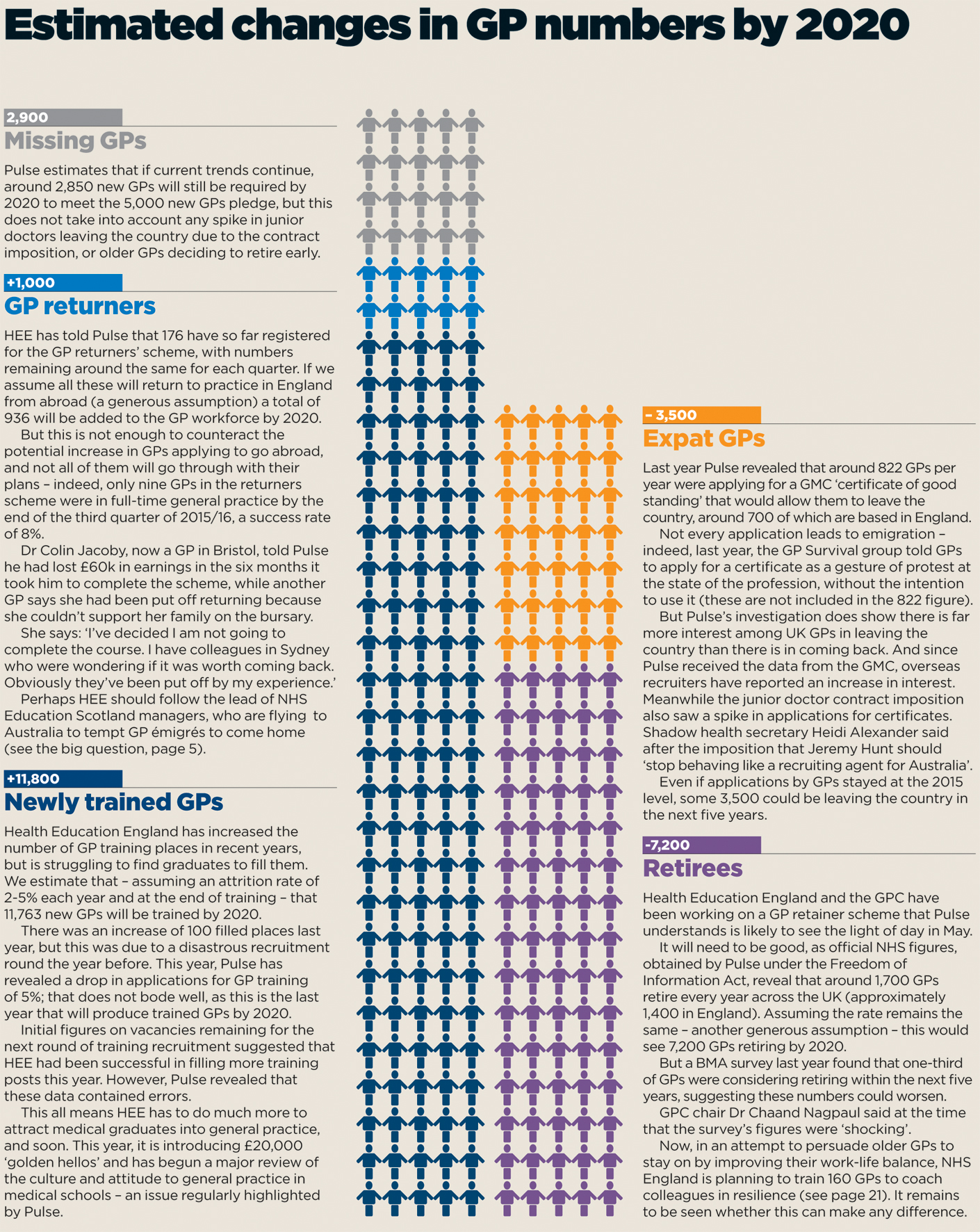
Office worker with speech bubble 3×2
‘I can today confirm plans to train and retain an extra 5,000 GPs,’ health secretary Jeremy Hunt told cheering delegates at the Conservative party conference in 2014. But the applause is now sounding rather hollow.
A Pulse analysis of workforce data reveals that if current trends continue, just 2,100 new GPs will be delivered by 2020. And that is a best-case scenario; there are looming storm clouds that could knock even this optimistic projection off course. It does not factor in the harm done by the junior doctor contract dispute and any further damage to GP morale. It also assumes that more UK-trained GPs can be attracted from abroad – an unlikely prospect.
Nevertheless, if Pulse’s estimate proves accurate, this would be a disaster for the Conservatives’ entire pre-election plan for the NHS. General practice needs at least 5,000 new GPs to stand still and there will not be enough GPs to provide seven-day access or lead on the £10bn plan to produce ‘new models of care’.

Estimated changes in gp numbers by 2020
On every front, health education chiefs are floundering. A 10-point plan to increase the numbers of GPs in training and bring back returners is – based on current trends – likely to bring in just a few hundred extra trained GPs. Two years on from his pledge, Mr Hunt has still to introduce any major scheme to address the 1,400 GPs retiring every year, while hundreds are applying to take their much-needed skills abroad.
Whitehall mandarins are frantically trying to gerrymander the figures, rebranding Mr Hunt’s pledge as 5,000 ‘doctors in general practice’ (see box below). But even with the extra time that would give, it is difficult to see how the trend could be reversed. A Health Education England (HEE) marketing campaign featuring GPs signing forms to allow patients to go skydiving has dive-bombed. As Dr Stuart Sutton, former chair of the RCGP’s Associates in Training committee, put it: ‘If the highlight of a GP career is signing skydive forms, I’m off to watch paint dry.’
And many other medical graduates agreed – with Pulse revealing earlier this year a 5% drop in applications for general practice.
But HEE has several irons in the fire for the next 12 months. It is introducing £20,000 ‘golden hellos’ for trainees to work in areas with poor recruitment – such as Blackpool and the Isle of Wight – and is planning a major review of culture within medical schools to ensure prospective new GPs are not being put off.
Ongoing dispute
It is also introducing a fast-track scheme for applicants who score highly on the entrance exam to GP specialty training and the facility to defer starting training for up to 12 months.
But the ongoing dispute on the junior doctors’ contract could undermine this work, with many bright young people put off medicine altogether by all the adverse publicity about working hours. There are already reports of large increases in the number of junior doctors applying to go abroad to complete specialist training.
How the Government’s target has been diluted
The DH now claims that the target of 5,000 extra GPs by 2020 will also include doctors in training, effectively giving it three more years to boost numbers.
But this was not health secretary Jeremy Hunt’s original pledge to the Conservative Party conference. His words were: ‘Tory conference, I can today confirm plans to train and retain an extra 5,000 GPs.’
And this was the rhetoric leading up to general election, with the DH saying it was committed to bringing ‘5,000 more GPs’ into the system by 2020.
But this rhetoric changed when Mr Hunt announced his ‘new deal’ in June 2015. The health secretary also said in the subsequent Q&A session that there would be ‘flexibility [in the target] because in some parts of the country it is very hard to recruit GPs’.
On the other side of the scales, Pulse has obtained data from the NHS Business Authority that show the current rate of GP retirement in England is around 1,400 per year. Some may be tempted back part-time, but this still represents a huge loss when the country needs every GP it can get.
Pulse understands the GPC is close to agreeing a ‘retainer scheme’ that will see practices given more funding if older GPs are persuaded not to leave, and Pulse recently revealed that the Department of Health was training 160 ‘resilience’ coaches to help keep burnt out members of the profession working.
But, again, the Government has waited too long to address this problem and its ‘reforms’ to seniority payments and public sector pensions – in particular the cap on tax relief – are actively encouraging older GPs to consider jacking it all in.
A major BMA survey of 16,000 grassroots GPs last year found that one-third of GPs were thinking of retiring from the profession within five years. Burnout is a major issue, with a Pulse survey last year showing half of GPs were at risk, and despite promising comprehensive occupational health provision for all GPs, NHS England has failed to put any new support in place.
‘There is a risk whether we will be able to get that number of people into general practice. However, without that, it will be difficult to deliver our ambitions.’
Lord Prior, health minister
GPC education, training and workforce subcommittee chair Dr Krishna Kasaraneni says: ‘The political pledge to recruit 5,000 GPs by 2020 is wholly unrealistic. Pulse’s data analysis shows how short we are likely to be. We actually need a lot more GPs than this arbitrarily chosen figure to maintain a basic level of service to patients. With 600 GP trainee posts left unfilled last year and large sections of the workforce telling the BMA they intend to retire, there is little chance the Government will get anywhere near this target.’
Workforce experts endorse Pulse’s recruitment figures, but say there is work going on behind the scenes to ensure the 5,000 target is achieved. Professor Martin Roland – who authored a landmark review into the primary care workforce last month – says a ‘whole raft of measures’ will be included in the new ‘roadmap’ package for GPs next month, which will seek to implement his recommendations to broaden the skill mix to include physician associates, pharmacists and paramedics.
Professor Roland says of the Pulse figures: ‘The main problem I see is that you don’t take account all the efforts that are taking place to improve things – in particular things in the forthcoming “Road Map for General Practice” that NHS England will be publish in the next few weeks – which are designed to increase morale, recruitment and retention and make return to practice easier.
‘So yes, if things continue as they are you may be right, but there’s a lot of effort going into ensuring that they don’t.’
During the last parliament, the DH increased the GP workforce by 1,000 full-time-equivalent GPs and insists it is ‘on track’ to meet its target of 5,000 more doctors in general practice by 2020. A spokesperson says: ‘Pulse’s figures don’t take the whole picture into account.
‘NHS England and HEE are working closely with the BMA and RCGP on a 10-point plan which sets out exactly how we will achieve this. We have been clear that our target includes registrars.’
However, even ministers argue for caution. Lord Prior – the former CQC chair said in the House of Lords this month: ‘There is a risk whether we will be able to get that number of people into general practice. However, without that, it will be difficult to deliver our ambitions.’
Pulse October survey
Take our July 2025 survey to potentially win £1.000 worth of tokens













